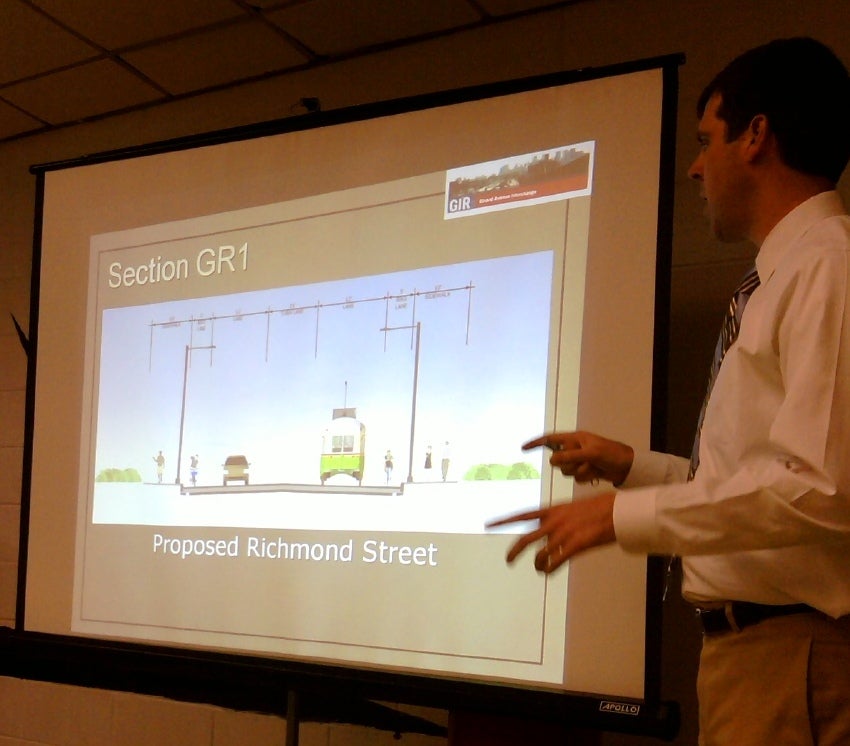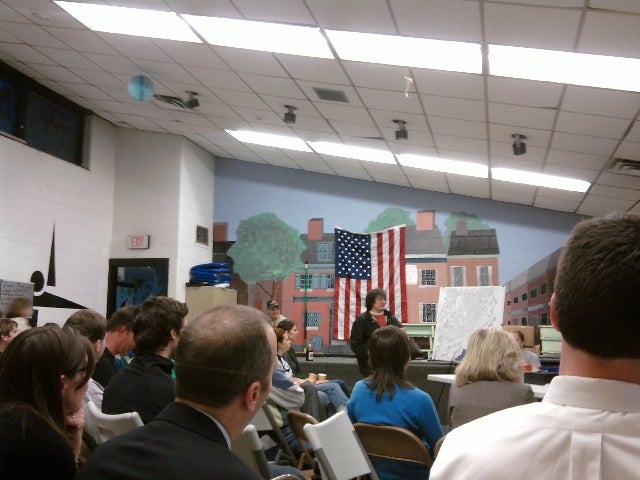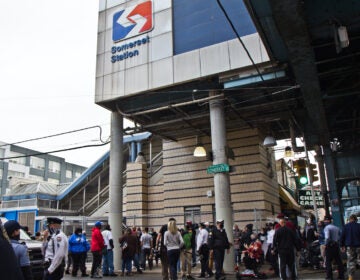I-95 / Girard Ave. construction update
March 19, 2010
By Kellie Patrick Gates
For PlanPhilly
The I-95 Girard Avenue interchange that crews have been working on since last summer will open in July, representatives from PennDOT and its engineering consultant, URS Corporation, told about 100 Fishtown residents Thursday night.
The opening will reduce traffic congestion on Girard Avenue and create better riverfront access, PennDOT project manager Elaine Elbich said. That’s because drivers will “be able to make a left hand turn to get down to the riverfront and Delaware Avenue.” The finished work will also make it easier to get to SugarHouse Casino, under construction on the Fishtown waterfront.
The opening of the exchange is a milestone for the I-95 project, which began in 1999. But it is just the beginning, according to the work outlined by Elbich and URS project manager Mark A. Rhoads. In fact, the interchange opening this summer is temporary and its permanent replacement won’t be ready until 2015. The whole Girard section of the I-95 revitalization project, which stretches from Allegheny Avenue to Cottman, won’t be finished until about 2019, and will cost about $450 million.
There’s a lot that will happen between now and then.
Check out PennDOT’s I-95 Revive, plenty of maps and visuals
https://www.youtube.com/watch?v=C3E1TYNg_wU
The next part of the project, which is in the final design stages, deals with the places where I-95 crosses city streets. “We’ve been doing a lot of behind-the-scenes stuff,” Elbich said. PennDOT has been talking with groups involved with neighborhood and waterfront development, including City agencies, the Delaware River Waterfront Corporation, and the Friends of Penn Treaty Park.
More community meetings will be held dealing with all elements of the Girard project, said Marian Hull, who does planning and public outreach for URS. “It’s a complex project that involves waterfront visioning, neighborhood plans and CDC plans,” she said. URS is in the process of developing graphics to explain what’s happening – graphics one doesn’t have to be an engineer to understand, Hull said.
Over the next few months, Hull will be coordinating meetings with the city, the Delaware River Waterfront Corporation, civic associations and other groups who have plans for infrastructure improvements at or near I-95. Among the goals of the meetings: Establishing clear expectations for what portions of these projects can be accomplished by PennDOT as part of the I-95 improvement project.
No details on how all of this will work are yet available, Hull said, but that will be determined within the next month or so. More information and design meeting schedules will be available in the next two to three months, she said.
Rhoads went over some highlights for the next nine years of construction.
https://www.youtube.com/watch?v=fujv6dmPxSc
The temporary interchange is labeled GR0, and the remaining phases have sequential numbers from GR01 to GR5.
GR01 focuses on moving Richmond Street east onto the Conrail property, to make more room for I-95 improvements. Construction will begin in spring 2011, and will finish in summer or fall of 2013.
All of the streets that currently reach Richmond will be extended to its new, more easterly location. Surface improvements will be made both on Richmond Street and Girard Avenue, Rhoads said. And the new Richmond Street will be lowered beneath the Conrail underpass. There’s now about 12 feet between the bottom of the underpass and the street, he said. The space will increase to about 14 feet, six inches, to allow for trucks to pass more easily. “There’s a perpetual jam-up of trucks getting stuck beneath the railroad. It’s not a safe condition,” he said.
Trolley service will be re-established, but during construction, SEPTA will be busing passengers around the work zones, Rhoads said.
https://www.youtube.com/watch?v=b8F7e2QhoQc
Work on GR2, which focuses on repairing the road surface from Shackamaxon to Columbia streets, including the I-95 bridges of Shackamaxon, Marlborough and Columbia, will start in summer 2012 and take two years to complete.
Phases GR3 and GR4 will involve work done from Columbia north to nearly Allegheny Avenue. Lane drops – places where traffic lanes suddenly disappear – are going to be eliminated. GR3, which encompasses the northbound lanes, will run from fall 2013 to fall 2015; GR4, covering the southbound lanes, will start fall in fall of 2016 and run through fall of 2018.
GR3 also includes additional work on Delaware Avenue and the replacement of temporary work on the Girard Interchange.
https://www.youtube.com/watch?v=PbC_1v8vK9Q
Rhoads showed renderings of what Delaware Avenue might look like between Columbia and Aramingo. There are six traffic lanes – three in each direction – but they have been narrowed to 11 feet to reduce the amount of highway pedestrians must cross. There is a landscaped median – good for both storm water management and pedestrian safety. Bike lanes line the highway, and are flanked by sidewalks that Rhoads said would be at least 10-feet wide. There are more landscaped strips beyond the sidewalks. “We’re coordinating quite extensively with the Philadelphia Water Department and DEP,” Rhoads said.
Another rendering showed Delaware Avenue at Columbia, near Penn Treaty Park. Looking south, there are crosswalks to take pedestrians across Delaware Avenue on either side of Columbia, and medians in the roadway at each of them.
John Connors, a long-time advocate for Penn Treaty Park, praised the addition of those islands, which he said would make crossing to the park much safer, especially for the elderly and people with kids.
https://www.youtube.com/watch?v=UJz1lVtBWkg
GR5 focuses on the portion of the highway that stretches from Shackamaxon to Race Street. The highway will be reconstructed in both directions. “We’re going to widen the ramps to the Vine Street Interchange,” Rhoads said. Now, going out of the city, east on Vine Street to northbound I-95, “you start out as three lanes, you end up as one, right when you hit 95. So we’re going to widen that out to two lanes where it joins I-95, to try and alleviate some of that congestion.” GR5 construction is set to run from Fall 2017 to Fall 2019.
Rhoads and Elbich took questions from the audience, and the discussion, which can be seen in its entirety on the videos, covered topics from residents’ long-standing wishes for sound barriers to the desire for left-hand turning lanes and more stop lights.
Elbich said that the sound barrier question would have to come up for a community vote. Some communities vote against them, she said, because they can block light and views. Rhoads said that signals would only be added where traffic studies indicated they are needed, but one resident asked him to remember that traffic signals aren’t just for cars; they help pedestrians cross roadways.
Elbich and Rhoads said anyone who has a question about the I-95 project can submit it via the 95 Revive website. (Go here, and scroll to the very bottom of the page. http://www.95revive.com/reviving-interstate-95-overview.aspx) Rhoads said questions are answered within a few days.
The entire I-95 improvement project, which stretches from Vine Street to Academy Road, will cost about $1.1 billion, with 80 percent of design costs and 90 percent of construction costs coming from the federal government. The state will pay the balance.
https://www.youtube.com/watch?v=qTz4QgZAW-Q
Contact the reporter at kelliespatrick@gmail.com
WHYY is your source for fact-based, in-depth journalism and information. As a nonprofit organization, we rely on financial support from readers like you. Please give today.







